Estimates suggest that about 43 species of shark can be found in the Atlantic Ocean. These range from the ferocious bull shark to the rather calm lemon shark. What’s important about such a large body of water, however, are the large species that dominate it.
Sharks are deadly aquatic predators, with many species bearing the title of apex predators. They are unparalleled when it comes to detecting prey and arriving unnoticed. This article will introduce you to the 9 biggest sharks in the Atlantic Ocean.
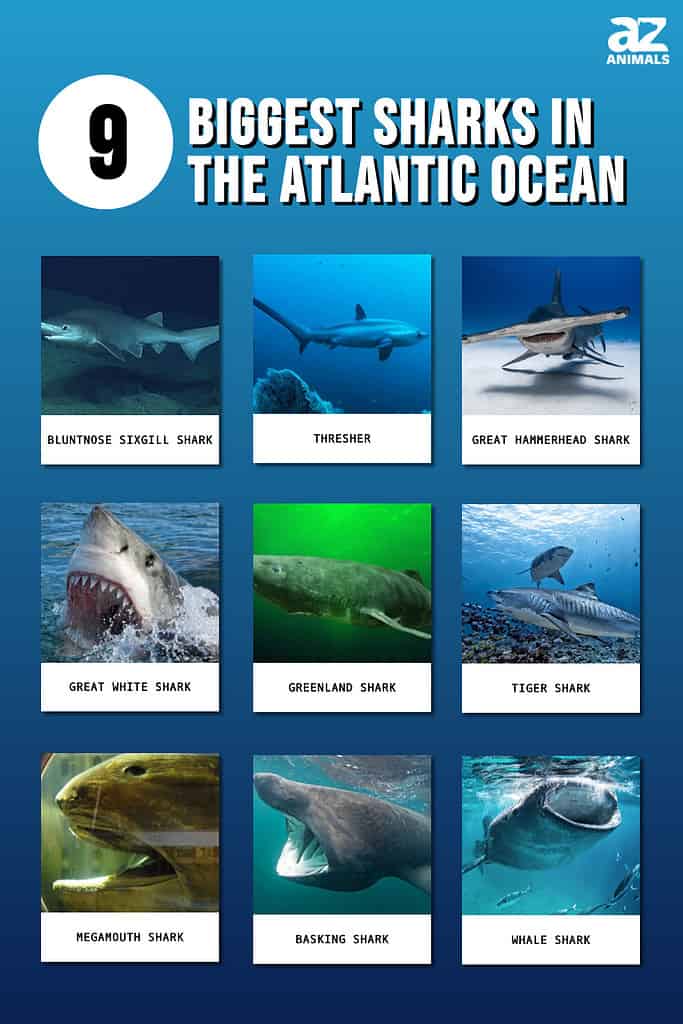
Be cautious, as these nine are all species you could see from a cruise ship or encounter while diving or snorkeling. The latter should be done only in the presence of professionals in the field!
Bluntnose Sixgill Shark
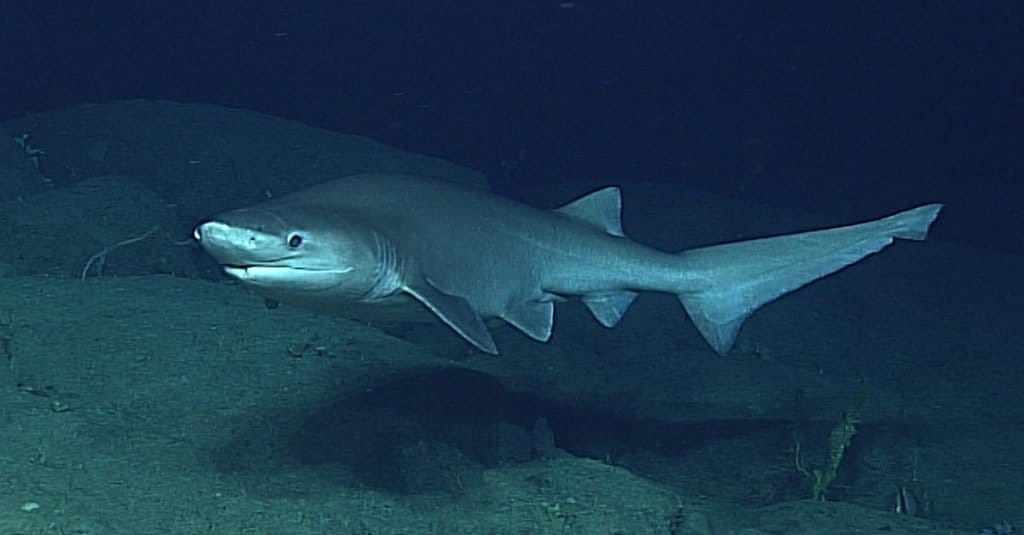
The bluntnose sixgill shark is found in tropical and temperate waters.
©NOAA Ocean Explorer from USA / CC BY-SA 2.0 – Original / License
| Scientific name | Habitat/Area | Average length | Largest specimen |
|---|---|---|---|
| Hexanchus griseus | Tropical and temperate waters | 10-14 feet (3.1-4.2 m) | 26.5 feet (8m) – not backed by any reliable data |
Often called the cow shark, the bluntnose sixgill shark is found in tropical and temperate waters, regardless of the ocean. The species can grow up to 20 feet (6.1 m), but specimens usually average 10–14 feet (3.1–4.2 m). The cow shark is about 1,102 lb (500 kg) in weight.
The bluntnose sixgill shark is found worldwide – in Greece, Argentina, North Carolina, Japan, Namibia, etc. It usually stays at a depth of 590–3,610 feet (180–1,100 m), but it can go lower if needed.
One key characteristic of the species is its feeding behavior. Cow sharks can protrude their jaws and adapt to catching and feeding methods depending on the situation and environment.
Thresher Shark
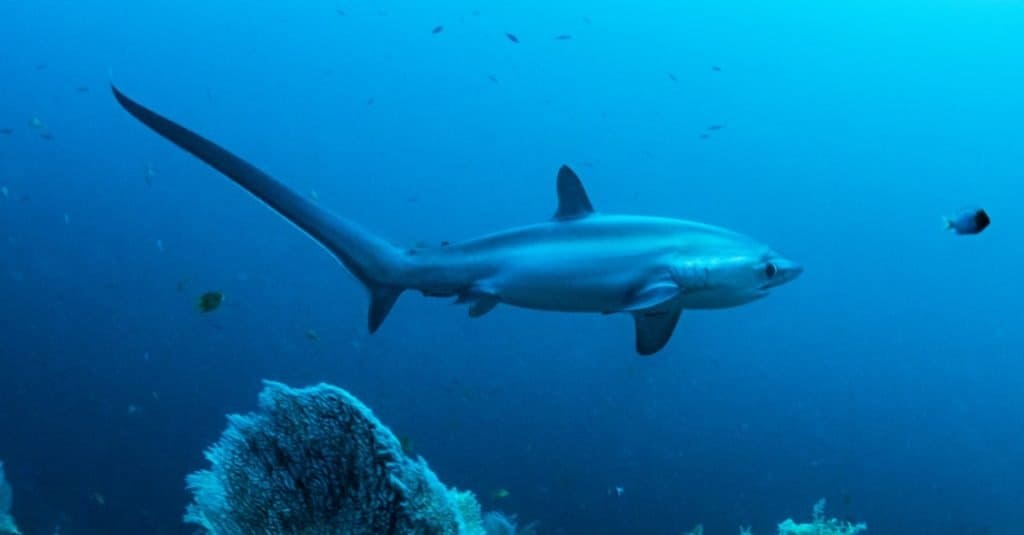
The thresher shark feeds on bluefish, mackerel, juvenile tuna, cuttlefish, and squid.
©Shane Gross/Shutterstock.com
| Scientific name | Habitat/Area | Average length | Largest specimen |
|---|---|---|---|
| Alopias vulpinus | Temperate and tropical oceans | 20 feet (6.1 m) | 24.9 feet (7.6 m) |
The thresher shark is known for its impressive tail and the fact that it leaps out of the water, breaching it. The shark’s tail can be as long as the fish’s body – for an average total length of 40 feet (12.2 m). The species inhabits open ocean waters but is sometimes seen in coastal waters. Thresher sharks prefer depths of about 1,600 feet (500 m) or lower.
The thresher shark feeds on bluefish, mackerel, juvenile tuna, cuttlefish, and squid. Its tail is not there just for looks. It can be used to stun prey, aiding the shark in hunting. The thresher shark is a solitary species, but specimens are often found hunting together.
Great Hammerhead Shark
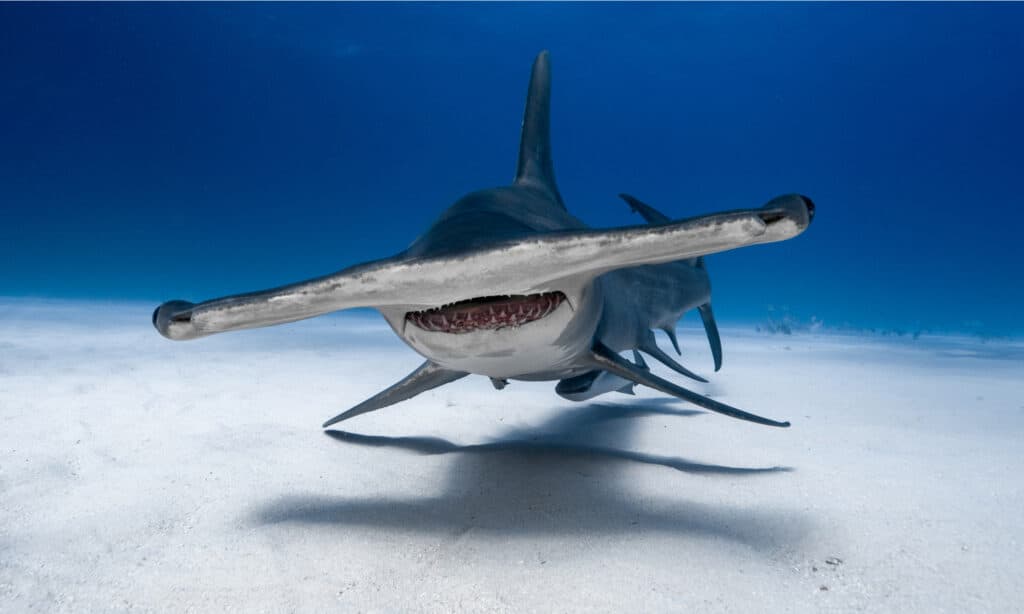
Great
hammerhead sharks
feed on smaller sharks, bony fish, cephalopods, and crustaceans.
©Sail Far Dive Deep/Shutterstock.com
| Scientific name | Habitat/Area | Average length | Largest specimen |
|---|---|---|---|
| Sphyrna mokarran | Tropical and warm temperate waters | 15 feet (4.6 m) | 20 feet (6.1 m) |
The great hammerhead shark is the largest species of the Sphyrna genus. It is known as a solitary apex predator with incredible swimming abilities. The usual great hammerhead specimen is about 11 feet (3.5 m) long, while the average is 15 feet (4.6 m).
This species can be distinguished from other hammerheads by the straight leading edge on each side of the hammerhead.
Great hammerhead sharks feed on smaller sharks, bony fish, cephalopods, and crustaceans. Due to intense fishing, the species is now considered critically endangered (even if female great hammerheads have litters of up to 5000 pups).
Great White Shark

Great white sharks are the largest extant macropredatory fish in the world.
©Martin Prochazkacz/Shutterstock.com
| Scientific name | Habitat/Area | Average length | Largest specimen |
|---|---|---|---|
| Carcharodon carcharias | Coastal surface waters | 11-16 feet (3.4-4.9 m) | 19.5 feet (5.9 m) |
The great white shark is known for having one of the longest lifespans among cartilaginous fishes. It can live up to 70 years (or more). The average male specimen size is 11–13 feet (3.4–4.0 m), while the average female is 15–16 feet (4.6–4.9 m).
Great white sharks are the largest extant macropredatory fish in the world. They have no natural predators but are sometimes hunted down by orcas. They are extremely dangerous to humans, having the most recorded human bites among sharks.
Two unconfirmed great whites are much larger than the largest reliably measured specimen. One is 36 feet (10.9 m) long, and the other is 37 feet (11.3 m) long. However, due to invalid measurement methods, their size is often questioned.
Greenland Shark
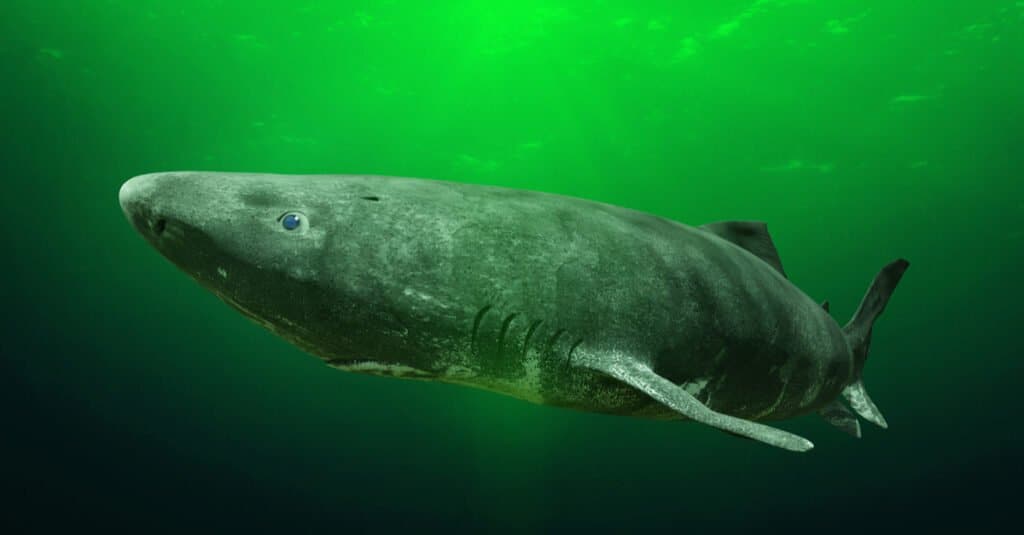
Most documented Greenland sharks are 8–16 feet long and weigh about 880 lbs.
©Dotted Yeti/Shutterstock.com
| Scientific name | Habitat/Area | Average length | Largest specimen |
|---|---|---|---|
| Somniosus microcephalus | North Atlantic Ocean | 21 feet (6.4 m) | 24 feet (7.3 m) |
The Greenland shark is a sleeper shark that can live up to 250–500 years. It is also one of the biggest extant species worldwide. The shark lives in the depths of the North Atlantic and Arctic Oceans. Continuous living in such conditions caused the shark’s meat to become toxic (due to high trimethylamine N-oxide concentrations).
Most documented Greenland sharks are 8–16 feet (2.4–4.8 m) and weigh about 880 lbs (400 kg). They eat various fish and also seals. Research suggests that the diet of the Greenland shark changes depending on its size. The smaller specimens eat squid, while the larger ones eat redfish.
Even though they prefer cold water habitats (as low as 31 °F (-0.6 °C), Greenland sharks were discovered in the Gulf of Mexico in water as warm as 39.4 °F (4.1 °C). Specimens were also found at abnormal depths considering its preferences – 5,738 feet (1,749 m) and even at 0–4,900 feet (0–1,500 m).
Tiger Shark

The tiger shark is a large macropredator found mainly in tropical and temperate waters.
©le bouil baptiste/Shutterstock.com
| Scientific name | Habitat/Area | Average length | Largest specimen |
|---|---|---|---|
| Galeocerdo cuvier | Tropical and temperate waters | 10.7-13.9 feet (3.4-4.2 m) | 16.4 feet (5 m) |
The tiger shark is a large macropredator found mainly in tropical and temperate waters. Its name is based on the dark stripes that run down its body, similar to a tiger’s pattern. Solitary nocturnal hunters and tiger sharks are known for their wide food spectrum. They eat anything from fish to seals, crustaceans, birds, dolphins, sea snakes, and smaller sharks.
The species is the second-deadliest in the world in terms of recorded fatal attacks on humans (the great white is the first).
In terms of length, average specimens are 10.7–13.9 feet (3.4–4.2 m). However, exceptional individuals, such as a 24.2 feet (7.4 m) catch, have been recorded but not fully verified.
Megamouth Shark
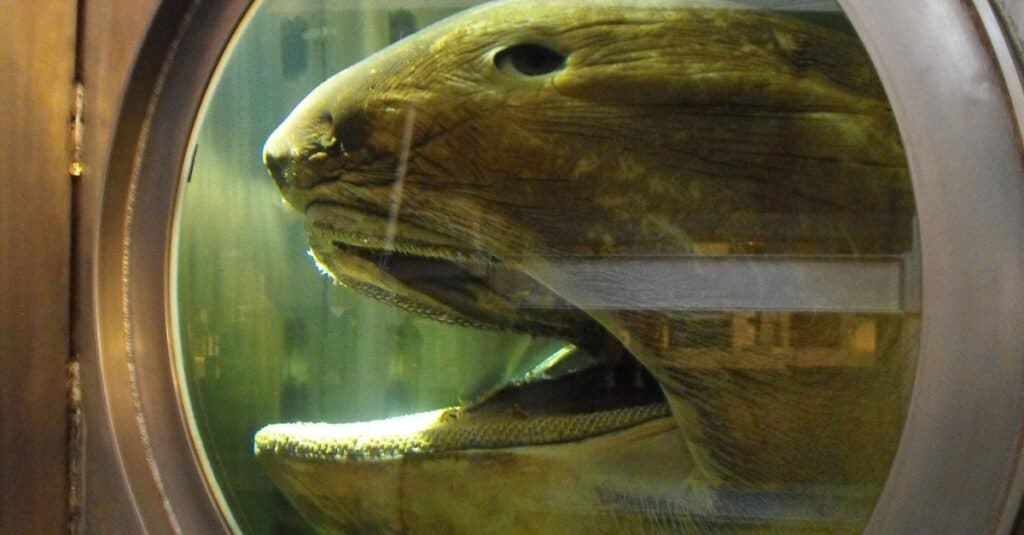
The megamouth is a rarely seen deepwater shark.
| Scientific name | Habitat/Area | Average length | Largest specimen |
|---|---|---|---|
| Megachasma pelagios | Pacific, Atlantic, and Indian Oceans | 13-16 feet (4-5 m) | 18 feet (5.5 m) |
The megamouth is a rarely seen deepwater shark. It is one of the three filter-feeding sharks (and the smaller one). Megamouths live so far below that only 100 specimens have been caught or seen since the species’ discovery in 1976.
The mouth of a megamouth can be as wide as 4 feet, 3 inches (1.3 m). Even though they are poor swimmers (no caudal keels, flabby body, asymmetrical tail), they can be found as deep as 3,280 feet (1,000 m).
Little is known about the megamouth besides appearance, feeding method, size, weight, and mouth structure. This is because the species is a very slow swimmer (0.93–1.30 mph (1.5–2.1km/h)) and ascends to the surface only at night.
Basking Shark

The basking shark is the second-largest shark species and fish worldwide.
©Martin Prochazkacz/Shutterstock.com
| Scientific name | Habitat/Area | Average length | Largest specimen |
|---|---|---|---|
| Cetorhinus maximus | Boreal to warm-temperate waters | 23-28 feet (7-8.5 m) | 40.3 feet (12.3 m) |
The basking shark is the second-largest shark species and fish worldwide. It is a filter-feeder alongside megamouths and whale sharks. While specimens average 23–28 feet (7–8.5 m) in length, some basking sharks can grow up to 30–36 feet (9–11 m). A basking shark in Canada’s Bay of Fundy was the largest specimen ever found. It was 40.3 feet long (12.3 m).
As their name suggests, basking sharks can be found at the water’s surface. After diving, they can go as deep as 2,990 feet (910 m). The species prefers cooler temperatures but is known to swim in warm-temperate waters.
The basking shark’s main diet consists of plankton concentrations, tiny fish, invertebrates, and zooplankton.
Whale Shark
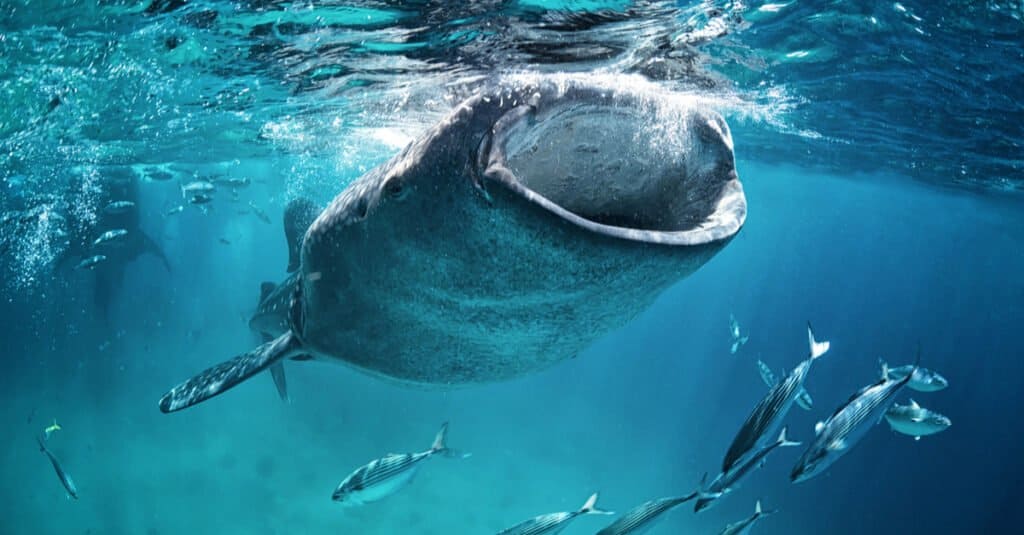
The whale shark is the largest known fish worldwide.
©Fata Morgana by Andrew Marriott/Shutterstock.com
| Scientific name | Habitat/Area | Average length | Largest specimen |
|---|---|---|---|
| Rhincodon typus | Tropical oceans | 26-30 feet (8-9 m) – for male specimens 48 feet (14.5 m) – for female specimens, based on a study | 61.7 feet (18.8 m) |
The whale shark is the largest known fish worldwide. The species was discovered and described in 1828. It is a large filter-feeder, often referred to as the largest living nonmammalian vertebrate. It prefers warm waters and can live up to 130 years.
As filter-feeders, whale sharks have mouths equipped with thousands of tiny teeth (over 300 rows). Their mouth also features 20 filter pads that they use during the feeding process. A large specimen can have a mouth 5.1 feet (1.5 m) across.
There are several reports of large individuals. Since the 1800s, specimens of 70 feet (21 m), 50 feet (15m), and 45 feet (14m) have been reported. None can be verified, so the largest accurately measured whale shark remains a 61.7 foot (18.8 m) individual.
Summary of the 9 Biggest Sharks in the Atlantic Ocean
| Name of Shark | Habitat | Average Length in Feet |
|---|---|---|
| Whale | Tropical Oceans | 26-30 for males; 48 for females. |
| Basking | Boreal to temperate waters | 23-28 |
| Megamouth | Pacific, Atlantic, and Indian Oceans | 13-16 |
| Tiger | Tropical and temperate waters | 10.7-13.9 |
| Greenland | North Atlantic Ocean | 21 |
| Great White | Coastal surface waters | 11-16 |
| Great Hammerhead | Tropical and temperate waters | 15 |
| Thresher | Tropical and temperate waters | 20 |
| Bluntnose Sixgill | Tropical and temperate waters | 10-14 |
The photo featured at the top of this post is © Tee Wong/Shutterstock.com
Thank you for reading! Have some feedback for us? Contact the AZ Animals editorial team.







